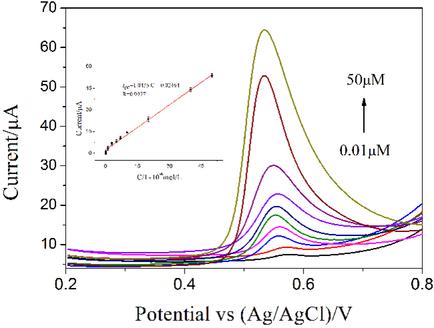当前位置:
X-MOL 学术
›
Electroanalysis
›
论文详情
Our official English website, www.x-mol.net, welcomes your feedback! (Note: you will need to create a separate account there.)
Sensitive Electrochemical Detection of Bisphenol A Using Molybdenum Disulfide/Au Nanorod Composites Modified Glassy Carbon Electrode
Electroanalysis ( IF 3 ) Pub Date : 2017-09-11 , DOI: 10.1002/elan.201700411 Mingxia Wang 1 , Yifei Shi 1 , Yubin Zhang 1 , Yang Wang 1 , Huayu Huang 1 , Jiangyi Zhang 1 , Jinxi Song 1
Electroanalysis ( IF 3 ) Pub Date : 2017-09-11 , DOI: 10.1002/elan.201700411 Mingxia Wang 1 , Yifei Shi 1 , Yubin Zhang 1 , Yang Wang 1 , Huayu Huang 1 , Jiangyi Zhang 1 , Jinxi Song 1
Affiliation

|
Bisphenol A, an important compound that is classified as an environmental hormone, has been proven to have harmful effects on human health and ecology. A molybdenum disulfide/Au nanorod-modified glassy carbon electrode was prepared as an electrochemical sensor for the detection of bisphenol A using a simple and convenient approach. UV–Vis spectrophotometry and transmission electron microscopy were employed to characterize the composite. The electrochemical behavior of bisphenol A at the modified electrode was investigated via differential pulse voltammetry and cyclic voltammetry. The results show that bisphenol A exhibits a good electrochemical signal at the modified electrode under optimized conditions, and a good linear relationship was observed between the bisphenol A concentration and peak current within the range of 0.01–50 μM, with a detection limit of 3.4 nM. Furthermore, the fabricated electrodes showed good anti-interference, reproducibility and stability. The proposed electrochemical method was successfully applied for the detection of bisphenol A in milk and water samples, and its potential for applications in pollutant detection was demonstrated.
中文翻译:

使用二硫化钼/金纳米棒复合材料修饰的玻碳电极对双酚 A 进行灵敏的电化学检测
双酚A是一种被归类为环境激素的重要化合物,已被证明对人类健康和生态有有害影响。使用简单方便的方法制备了二硫化钼/金纳米棒修饰的玻碳电极作为检测双酚A的电化学传感器。紫外-可见分光光度法和透射电子显微镜被用来表征复合材料。通过微分脉冲伏安法和循环伏安法研究了双酚 A 在修饰电极上的电化学行为。结果表明,双酚A在优化条件下在修饰电极上表现出良好的电化学信号,在0.01-50 μM范围内,双酚A浓度与峰值电流之间存在良好的线性关系,检测限为 3.4 nM。此外,制备的电极显示出良好的抗干扰性、重现性和稳定性。所提出的电化学方法已成功应用于牛奶和水样中双酚 A 的检测,并证明了其在污染物检测中的应用潜力。
更新日期:2017-09-11
中文翻译:

使用二硫化钼/金纳米棒复合材料修饰的玻碳电极对双酚 A 进行灵敏的电化学检测
双酚A是一种被归类为环境激素的重要化合物,已被证明对人类健康和生态有有害影响。使用简单方便的方法制备了二硫化钼/金纳米棒修饰的玻碳电极作为检测双酚A的电化学传感器。紫外-可见分光光度法和透射电子显微镜被用来表征复合材料。通过微分脉冲伏安法和循环伏安法研究了双酚 A 在修饰电极上的电化学行为。结果表明,双酚A在优化条件下在修饰电极上表现出良好的电化学信号,在0.01-50 μM范围内,双酚A浓度与峰值电流之间存在良好的线性关系,检测限为 3.4 nM。此外,制备的电极显示出良好的抗干扰性、重现性和稳定性。所提出的电化学方法已成功应用于牛奶和水样中双酚 A 的检测,并证明了其在污染物检测中的应用潜力。



























 京公网安备 11010802027423号
京公网安备 11010802027423号